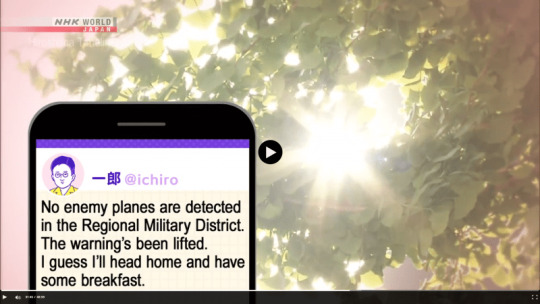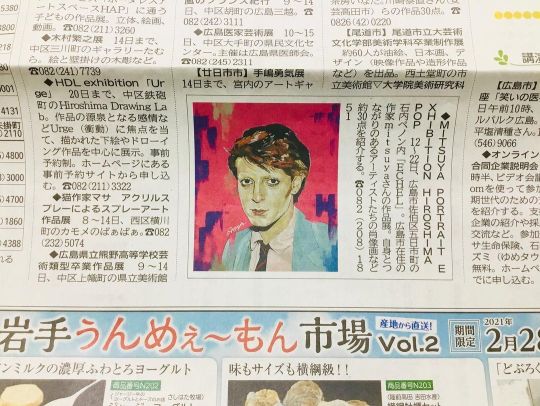#Chugoku Shimbun Newspaper
Explore tagged Tumblr posts
Text
2024年春の仕事
ここへ来てようやく春らしい陽射しが注いでくるようになりました。それまで福岡では、気温は平年と変わらないものの、重い雲が垂れ込め、時折雨風が強くなる日が続いていて、気分も体調も落ち込むことが多かったので嬉しく思っています。学期の始まり��慌ただしさもようやくひと段落し、溜め込んだ仕事に少しずつ取り組んでいるところです。美学と哲学の講義にも、またこれらを深めるゼミにも熱心な学生がいて刺激を受けています。ゼミではエドワード・W・サイードの晩年の著作を読み始めました。彼が何を問い続けてきたのかを顧みることをつうじて、現在の厳しい状況を見通す思考の方途を探れればと思います。 3月8日に広島交響楽団の演奏会を聴くために訪れた広島にて さて、3月から4月の仕事についてご報告しておきたいと思います。まず、書評紙『週間読書人』の3月1日号に、郁文堂から昨年末に刊行されたヨアヒム・ゼング編/細見和之訳『ア…

View On WordPress
#Béla Bartók#BBC Symphony Orchestra#Bohuslav Martinů#Christopher Noran#Chugoku Shimbun Newspaper#Erika Kobayashi#Goethe Institut Tokyo#Hiroshima Symphony Orchestra#Kazuyuki Hosomi#Kyoko Hayashi#Makoto Oda#Mayumi Kanagawa#Megumi Fukuda#Mercure des Arts#Nishinippon Shimbun Newspaper#Olivier Messiaen#Oppenheimer#Paul Celan#Peter Szondi#Research Group for Theory of Image#Research in Atomic Bomb Literature#Ryoko Aoki#Sayaka Shoji#Silvan Cambreling#Tadashi Tonoshiki#Tamiki Hara#Tatsuya Shimono#Theodor W. Adorno#Tokimate#Toshio Hosokawa
1 note
·
View note
Text
・The Hiroshima Peace Media Center
ABOUT US:▪️The Peace Media Center issues a special page of feature articles, published every week as an insert in the Chugoku Shimbun’s main newspaper. These articles, originally in Japanese, are translated into English to enhance the web content.
・Hiroshima and Nagasaki: A Multilingual Bibliography
「ABOUT US: The Aim of Our Project In 2014, a year before the 70th anniversary of the atomic bombings of Hiroshima and Nagasaki, we started our survey and research into the multilingual publication of atomic bomb literature. Our goal is to make a comprehensive survey into the process of worldwide acknowledgment of Hiroshima and Nagasaki for 70 years.」
・80歳を過ぎて語り始めた被爆体験――福島へ手渡したい思いとは(22/11/14)
「戦争に浮かれていたとしか思えない。切明さんの話は、「あの日」から始まるのではなく、軍都「廣島」の話から始まる。「広島は今、平和を守ることや、核兵器廃絶を掲げていますが、77年前までは軍国主義の街でした」切明さんが国民学校2年生の時、満州事変が起きる。広島城の周辺には陸軍の師団が置かれており、宇品港は中国大陸や、その後の東南アジアの国々侵略のための出発港だった。」
・報道特集「はだしのゲンが伝えてきたもの」(23/08/05)

※TBS報道特集の特集内容は、また1週間後にYoutubeの公式チャンネルで配信されるので、またその時にリンク貼り直します。
・被爆2世、女性として直面した複合差別 ――「韓国のヒロシマ」陜川から(23/02/26)
「2023年2月7日、被爆者の援護を定めた法の対象外となっているのは不当だとして、被爆2世が国を訴えていた裁判の判決が広島地裁で言い渡された。「不当な差別とは評価できない」などとして、原告の訴えは棄却された。被爆2世に対しては、厚生労働省が定めた要綱に基づく健康診断が実施されているものの、がん検診はそこに含まれず、各種手当の交付なども受けられない。」
「原爆被害に加え、それ以前からの植民地支配に翻弄されてきた韓国人被爆者の次世代も、「線引きの外側」に置かれ、��的な支えを受けられずに生きてきた。」
・被爆と出自、70年近く隠し続けた。今なぜ、自身の名で被爆体験を語るのか(21/08/05)
「植民地支配下の朝鮮半島で、生活基盤を失って渡日を余儀なくされた人々、労働力不足を補うために連れてこられた人々、鐘根さんのように二世となる世代など、敗戦時には200万人以上の朝鮮人が日本にいたとされている。韓国原爆被害者協会の推計では、広島と長崎で被爆した朝鮮半島出身者は約7万人にのぼるという。そんな朝鮮半島出身者の苦しみが、この社会で伝わっていないことを鐘根さんは痛感していく。」
・広島、原爆投下の犠牲になったアメリカ兵の記録(21/08)※上中下、3つの記事
「推計14万人の命を奪った史上初の原爆は、多くの日本人だけでなくその場にいた外国の人々にも襲いかかった。アトキンソンは広島で犠牲になった米軍捕虜12人の1人だった。」
「「残念ながら、あなたの夫ルーパー少尉は、広島で捕虜になっていた1945年8月6日に戦死した」終戦半年後の46年2月。行方不明とされていた米軍B24爆撃機「ロンサムレディー号」の副操縦士ダーデン・ルーパー=当時(22)=の妻ルースのもとに、軍から1通の手紙が届いた。絶望的な通知だったが、なぜ、どのように死んだのか詳しい説明はない。「ヒロシマ」「8月6日」…それは原爆で亡くなったことを暗示していた。何度も問い合わせたが、政府から情報は得られなかった。」
「1945年8月6日の広島への原爆投下時に爆心地そばにいた米兵12人のうち、多くは当日か数日内に死亡したとみられるが、2人は13日間生き延びた。だが、それは地獄のような壮絶な13日だった。」
・NHK戦争証言アーカイブス
・2023.08.06 広島原爆の日ドキュメント
2 notes
·
View notes
Photo

広島の郷土紙 中国新聞さんに掲載して頂きました。 新聞記事を見て広島のどこかに 「あっ❗️ミック・カーン⁉️」と驚く人がいるのだろうか? いたら面白いな〜😄 中国新聞様ありがとうございます。 An article about my exhibition was published in Hiroshima's most famous newspaper, "Chugoku Shimbun". #広島 #hiroshima #mickkarn #中国新聞 (Hiroshima) https://www.instagram.com/p/CK7NcGPpsH9/?igshid=1ot991qk1x1p8
1 note
·
View note
Text
‘Hiroshima Timeline’ uses tweets to portray real-time experience of world's first atomic bombing
New Post has been published on http://khalilhumam.com/hiroshima-timeline-uses-tweets-to-portray-real-time-experience-of-worlds-first-atomic-bombing/
‘Hiroshima Timeline’ uses tweets to portray real-time experience of world's first atomic bombing

Screencap from Hiroshima Timeline documentary on NHK on Demand.
To mark the 75th anniversary of the August 6, 1945 atomic bombing of Hiroshima, Japanese public broadcaster NHK has launched an innovative way to commemorate the world's first use of nuclear weapons. The “What If They Had Social Media in 1945” (もし、75年前にSNSがあったら) project uses imaginary tweets based on the diary entries of three people who lived through the bombing of Hiroshima. Three Twitter accounts created for the project share a chronology of real-time tweets before, during and after the attack on Hiroshima.
★スタッフからのお知らせ★
やすこさんの��イートは、1945年に今井泰子さん(当時26)が書いた日記をもとにしています。 日記原文

8/1~7https://t.co/sU31lGnvN1 現代の広島に暮らす3人の女性が日記や資料を読み込み、関係者への聞き取りを行いながら作っています。#ひろしまタイムライン — やすこ@ひろしまタイムライン (@nhk_1945yasuko) August 7, 2020
Yasuko's tweets are taken from the 1945 diaries of Imai Yasuko, then 26 years old. Her diary entries (written in Japanese) from August 1 to August 7, 1945 can be found at the following link: https://www.nhk.or.jp/hibaku-blog/timeline/genbun/yasuko/434035.html The diary entries came to be used for this project after three women who currently live in Hiroshima read them, and who then spread the word (about their importance).
Using three Twitter accounts, the Hiroshima Timeline project follows the lives in 1945 of Koichiro Osa (@nhk_1945ichiro), a 32-year-old reporter for the Chugoku Shimbun, Yasuko Imai (@nhk_1945yasuko), a 26-year-old homemaker pregnant with her first child, and Shunichiro Arai (@nhk_1945shun), 13, a junior high school student. On August 6, 1945, in the final days of World War II, an American aircraft dropped an atomic bomb on the city of Hiroshima in western Japan. Up to 80,000 people—30% of the population of Hiroshima at that time—were killed instantly, and much of the city was destroyed. Three days later, on August 9, 1945, the city of Nagasaki experienced a similar attack. For the Hiroshima Timeline project, three Twitter accounts were launched in late March, 2020, and used an “on-this-day” format to share observations and experiences of daily life from 75 years ago in the months leading up to the August 6, 1945 bombing. In April, 1945, Shunichiro Arai had just entered middle school and was still learning how things worked.
【1945年4月26日】 今日は数学の時間に平板測量というものをした。この時間に僕は級長に、一番大切にしていた消しゴムを貸してあげた。数学が終わり返してくれと言うと、失くしたと言う。そういうきちんとしてない所も、皆にバカにされてしまう理由なのかもしれない。#ひろしまタイムライン — シュン@ひろしまタイムライン (@nhk_1945shun) April 26, 2020
(April 26, 1945) Today in math class we learned about how to “survey area”. I gave the senior boy (head of class, 級長) my beloved eraser. While he said he would return it after math class, he said the eraser had “disappeared.” When he does careless things like this, it's no wonder everyone says he's an idiot.
According to an article in Tokyo Shimbun, the Hiroshima Timeline project was supervised by playwright Yaginuma Akinori. Ordinary citizens of Hiroshima of different ages and all walks of life participated in the project to help write the tweets. Participants read period newspaper articles and listened to stories by relatives in order to understand the lives, personalities, and sensibilities of the three people profiled in Hiroshima Timeline. The tweets were published according to corresponding diary entries, but were rewritten in a more accessible contemporary vernacular, all with the goal of presenting what ordinary people thought and felt in during wartime. The project also provides eyewitness accounts of the events of August 6, 1945, when an American aircraft dropped an atomic bomb on Hiroshima. Reporter Koichiro Osa had just finished breakfast at his suburban home and was preparing to go to work when the bomb exploded. Left with a mouthful of dirt, first he checked to make sure his wife was safe, before venturing towards the city center.
【1945年8月6日】 あれはなんだ! たけり狂う炎が、メリメリ、ゴーッと音を立てながら猿猴川の水を巻き上げている 地獄だ。大焦熱地獄。#ひろしまタイムライン#もし75年前にSNSがあったら — 一郎@ひろしまタイムライン (@nhk_1945ichiro) August 6, 2020
(August 6, 1945) What was THAT? A blazing fire is roiling up the water of the Sarugawa River, growling with a splintering, crackling roar. It is hell on Earth. A great fiery hell.
Junior high school student Shunichiro Arai also lived in a suburb of Hiroshima, but had already been on his way to school when the bomb exploded. He experienced gruesome scenes as he navigated the ruins of the city, including a slowly marching column of badly wounded burn and blast victims.
【1945年8月6日】 顔が崩れている…目も鼻も崩れている 人、じゃない、あんなふうにはならない 人の形をしているが…#ひろしまタイムライン#もし75年前にSNSがあったら — シュン@ひろしまタイムライン (@nhk_1945shun) August 6, 2020
(August 6, 1945) Faces totally destroyed, eyes, noses erased. These can't possibly be people, even if they are human forms…
Homemaker Yasuko, whose husband was away from Hiroshima, serving as a conscript in the military, also survived the initial blast. The Hiroshima Timeline described her experience in a tweet that was shared thousands of times:
【1945年8月6日】 ものすごい光 地響き、家が揺れて 電気の傘やガラスがふきとんで#ひろしまタイムライン#もし75年前にSNSがあったら — やすこ@ひろしまタイムライン (@nhk_1945yasuko) August 5, 2020
(August 6, 1945) An incredible flash of light, a rumbling in the earth, the whole house sways, as lampshades scatter and window panes are blown out.
The sense of realism is so strong that a concerned reader asks about Yasuko's unborn baby:
やすこさん! お腹の赤ちゃんも大丈夫でしょうか — ひだまり工房

高円寺 RAVEL様で委託販売中 (@genkiniikirudh) August 5, 2020
Yasuko-san! Is your child in your tummy all right?
The Twitter account for Yasuko Imai was managed in part by Hiroshima resident Naori Fukuoka, whose grandparents experienced the bombing, and then had to live through devastation and hardship that persisted for years following the end of the war in August, 1945. In an interview with Tokyo Shimbun, Fukuoka says:
8月6日に焼け野原になってたくさんの人が亡くなったことだけが原爆じゃない […] ずっと放射能の怖さを感じ、大勢の死傷者を見たトラウマ(心的外傷)と生きなくちゃいけない。原爆とは何だったか、私たちが考え出すのはこれからだと思う.
The atomic bomb not only killed all those people on a scorched field of earth field on August 6, 1945 […] Ever since that day we have all had to live in fear of radiation, and collectively we (in Hiroshima) have had to live with the trauma of witnessing mass death. When people wonder what happened on that day, from now on it is up to us to pass on that memory.
The Hiroshima Timeline project will continue to post tweets based on the diaries of the three eyewitnesses until the end of December, 2020. The Hiroshima Timeline timeline documentary is available to watch online.
Written by Nevin Thompson · comments (0) Donate · Share this: twitter facebook reddit
0 notes
Text
拙著『燃エガラからの思考』と渡邊英理『中上健次論』の刊行記念対談のご案内など
拙著『燃エガラからの思考──記憶の交差路としての広島へ』(インパクト出版会)を7月20日に上梓してから二か月が経とうとしています。この間、本書について二つの書評が公表されました。一つは図書新聞の第3557号(2022年9月3日付)に掲載された佐藤泉さんによる書評「無言の深みからなお歌われねばならない歌がある」です。拙著がエピグラフに掲げた原民喜の詩を出発点に、カタストロフィの後の詩の自己刷新が歴史の刷新に通じているという拙著の核心的な論点を取り出していただきました。また、批評的な思考によって「忘却装置」に組み込まれることを拒み、死者とともに生きることに踏みとどまるという本書の思想の分有が、軍備強化と「国葬」へ突き進もうとする現在の焦眉の課題であることも鮮やかに示していただいています。 もう一つは2022年9月18日付の中國新聞朝刊の読書欄に掲載された、この新聞の客員特別編集委員である佐…

View On WordPress
#Art Space Kimura Ask?#Artizon Museum#Chugoku Shimbun Newspaper#Eri Watanabe#Hanjiro Sakamoto#Hiroaki Sekiguchi#Hiromi Tsuchida#Hisashi Inoue#Inscript#Izumi Sato#Kenji Nakagami#Kumiko Kakehashi#Nobutaka Ueda#Nobuyuki Kakigi#Paul Celan#Shigeru Aoki#Tadashi Tonoshiki#Takefu International Composition Workshop#Takefu International Music Festival#Tamiki Hara#Toshoshimbun Newspaper#Two Journeys
0 notes
Photo

広島の郷土紙 中国新聞さんに掲載して頂きました。 新聞記事を見て広島のどこかに 「あっ❗️ミック・カーン⁉️」と驚く人がいるのだろうか? いたら面白いな〜😄 中国新聞様ありがとうございます。 An article about my exhibition was published in Hiroshima's most famous newspaper, "Chugoku Shimbun". #広島 #hiroshima #mickkarn #中国新聞 (Hiroshima) https://www.instagram.com/p/CK7NTs7JwXV/?igshid=1xxruph7a1rsg
1 note
·
View note